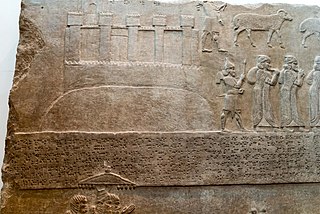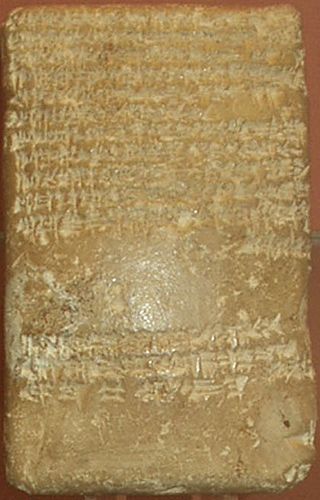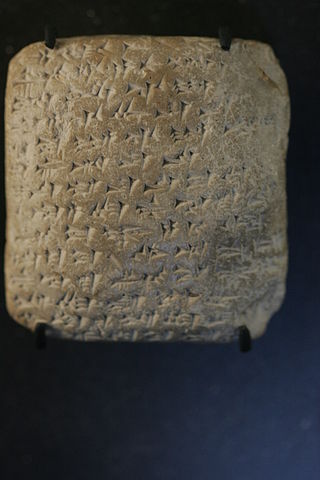Related Research Articles

The Amarna letters are an archive, written on clay tablets, primarily consisting of diplomatic correspondence between the Egyptian administration and its representatives in Canaan and Amurru, or neighboring kingdom leaders, during the New Kingdom, spanning a period of no more than thirty years between c. 1360–1332 BC. The letters were found in Upper Egypt at el-Amarna, the modern name for the ancient Egyptian capital of Akhetaten, founded by pharaoh Akhenaten (1350s–1330s BC) during the Eighteenth Dynasty of Egypt.

Labaya was the ruler of Shechem and warlord in the central hill country of southern Canaan during the Amarna Period. He lived contemporaneously with Pharaoh Akhenaten. Labaya is mentioned in several of the Amarna Letters. He is the author of letters EA 252–54.
Gina, mentioned in the Amarna Letters, was a town in ancient Canaan. The citizens of Gina were responsible for the death of Labaya. The town was later known as Beth-Hagan and was probably located roughly on the spot of the modern town of Jenin.

Abdi-Ḫeba was a local chieftain of Jerusalem during the Amarna period. Abdi-Ḫeba's name can be translated as "servant of Ḫebat", a Hurrian goddess. Whether Abdi-Ḫeba was himself of Hurrian descent is unknown, as is the relationship between the general populace of pre-Israelite Jerusalem and the Hurrians. Egyptian documents have him deny he was a mayor (ḫazānu) and assert he is a soldier (we'w), the implication being he was the son of a local chief sent to Egypt to receive military training there.

Biridiya was the ruler of Megiddo, northern part of the southern Levant, in the 14th century BC. At the time Megiddo was a city-state submitting to the Egyptian Empire. He is part of the intrigues surrounding the rebel Labaya of Shechem.

Tell Ashtara is an archaeological mound south of Damascus. The Bronze Age city that once stood here may have been mentioned in the Amarna letters correspondence of 1350 BC as Aštartu, and is usually identified with the Biblical city of Ashtaroth.

Ayyab was a ruler of Aštartu south of Damascus. According to the Amarna letters, cities/city-states and their kings in the region — just like countries to the north, such as Hatti of the Hittites, fell prey to a wave of attacks by Habiru raiders. The Amarna correspondence corpus covers a period from 1350–1335 BC.

Pawura, and also: Pauru, Piwure, Puuru/Puwuru was an Egyptian official of the 1350–1335 BC Amarna letters correspondence. As mentioned in letter no. 171, he was also an Egyptian "archer–commander". In letter no. 289 he is called an "irpi–official". In Egyptian his name means 'the Great One', (Pa-wr/Pa-ur)(letter EA 287:45-"1.-Pa-Ú-Ru")
Addaya was an Egyptian commissioner during the period of the Amarna letters correspondence. The majority of the Amarna letters were written to the pharaoh of Egypt during a 15-20 year(?) time period.

Karduniaš, also transcribed Kurduniash, Karduniash, Karaduniše,) is a Kassite term used for the kingdom centered on Babylonia and founded by the Kassite dynasty. It is used in the 1350-1335 BC Amarna letters correspondence, and is also used frequently in Middle Assyrian and Neo-Assyrian texts to refer to the kingdom of Babylon. The name Karaduniyaš is mainly used in the letters written between Kadashman-Enlil I or Burna-Buriash, Kings of Babylon, and the Pharaoh of Ancient Egypt -, letters EA 1-EA 11, a subcorpus of letters,.
Hannathon, and of the 1350-1335 BC Amarna letters, Hinnatuna, or Hinnatuni/Hinnatunu, is the Biblical city/city-state of Hannathon, ; in the Amarna letters correspondence as Hinnatuna, it is a site in southern Canaan, site uncertain. Ancient settlement of Tel Hanaton in Lower Galilee has been suggested as a candidate.

Amarna letter EA 252, titled: Sparing One's Enemies, is a square, mostly flat clay tablet letter written on both sides, and the bottom edge. Each text line was written with a horizontal line scribed below the text line, as well as a vertical left margin-line, scribe line on the obverse of the tablet. The letter contains 14 (15) lines on the obverse, continuing on the bottom tablet edge to conclude at line 31 on the reverse, leaving a small space before the final tablet edge. At least 4 lines from the obverse intrude into the text of the reverse, actually dividing the reverse into a top half and bottom half, and even creating a natural spacing segue to the reverse's text, and the story.

Amarna letter EA 271, titled: "The Power of the 'Apiru," is a moderately short, tallish, rectangular clay tablet letter, approximately 3 in wide x 4 in tall, from Milkilu the mayor/ruler of Gazru (Gezer), of the mid 14th century BC Amarna letters.

Amarna letter EA 289, titled: "A Reckoning Demanded," is a moderately tall, finely-inscribed clay tablet letter, approximately 6.5 in tall, from Abdi-Heba the mayor/ruler of Jerusalem, of the mid 14th century BC Amarna letters. The scribe of his six letters to Egypt were penned by the "Jerusalem scribe"; EA 289 is a moderately long, and involved letter, mentioning ten named individuals, some more than three times. A total of nine locations are referenced, as well as men of the "Hapiru"-("LÚ-MEŠ-Hapiru-ki"), and men of "Qilyi-ki".
Amarna letter EA 366 is from the king of Gath to the king of Egypt. The letter reports of the king having smote down the uprising of the Habiru.

Amarna letter EA 256, in short EA 256, catalogued under the title Oaths and Denials, is one of a total of about 350 so-called Amarna letters, belonging to an official correspondence dating to the mid-14th century BC. The initial corpus of letters were found at Akhenaten's city Akhetaten, on the floor of the Bureau of Correspondence of Pharaoh; others were later found, adding to the body of letters.
Amarna letter EA 254, titled: "Neither Rebel nor Delinquent (2)", is a moderate length, tall, and mostly flat rectangular clay tablet Amarna letter,. The letter is from Labaya of city-state Šakmu . It is an undamaged letter, in pristine condition, with cuneiform script on almost all surfaces: Obverse, Bottom, Reverse, and Left Side. Letter EA 254 is numbered VAT 335, from the Vorderasiatisches Museum Berlin.

Amarna letter EA 290, titled: "Three Against One", is one of the two shorter letters, of six, from Abdi-Heba the governing man of Jerusalem. In the Jerusalem letters, Jerusalem is "Uru-Salem" ("City-Peace").

Amarna letter EA 299, titled: "A Plea for Help", is a fairly short clay tablet Amarna letter from "governor" Yapahu of city-state Gazru. The clay tablet surface has been partially eroded, but the cuneiform is still mostly legible.

Amarna letter EA 75, titled: "Political Chaos", is a short to moderate length letter from Rib-Hadda, who wrote the largest number of Amarna letters in a sub-corpus, from the city-state of Byblos; Byblos contained an Ancient Egyptian colony, and was aligned with a few neighboring townsites.
References
- ↑ Moran, The Amarna Letters, pp 308-310.